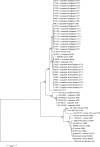Prevalence and genetic characterization of Powassan virus strains infecting Ixodes scapularis in Connecticut
- PMID: 22890037
- PMCID: PMC3516331
- DOI: 10.4269/ajtmh.2012.12-0294
Prevalence and genetic characterization of Powassan virus strains infecting Ixodes scapularis in Connecticut
Abstract
A total of 30 Powassan virus (POWV) isolates from Ixodes scapularis collected from Bridgeport and North Branford, CT in 2008, 2010, 2011, and 2012 and one earlier isolate from Ixodes cookei collected in Old Lyme, CT in 1978 were characterized by phylogenetic analysis of their envelope gene sequences. Powassan virus sequences segregated into two major groups termed the deer tick virus (DTV) and Powassan (POW) lineages. The lineage from I. cookei was POW. The remaining viruses from I. scapularis grouped with the DTV lineage. Powassan viruses from Bridgeport were nearly identical and clustered with a virus strain from a human in New York. Viruses from North Branford were homogeneous and grouped with viruses from Massachusetts, northwestern Connecticut, and Ontario. These findings suggest that POWV was independently introduced into these geographical locations in Connecticut and maintained focally in their respective environments. An improved method of isolation of POWV in vitro is described.
Figures
References
-
- Ebel GD. Update on Powassan virus: emergence of a North American tick-borne flavivirus. Annu Rev Entomol. 2010;55:95–110. - PubMed
-
- U.S. Geological Survey Powassan virus maps. 2011. http://diseasemaps.usgs.gov/index.htm Available at. Accessed May 3, 2012.
-
- Centers for Disease Control and Prevention Outbreak of Powassan encephalitis: Maine and Vermont, 1999–2001. MMWR Morb Mortal Wkly Rep. 2001;50:761–764. - PubMed
-
- Goldfield M, Austin SM, Black HC, Taylor BF, Altman R. A non-fatal human case of Powassan virus encephalitis. Am J Trop Med Hyg. 1973;22:78–81. - PubMed
Publication types
MeSH terms
Associated data
- Actions
- Actions
- Actions
- Actions
- Actions
- Actions
- Actions
- Actions
- Actions
- Actions
- Actions
- Actions
- Actions
- Actions
- Actions
- Actions
- Actions
- Actions
- Actions
- Actions
- Actions
- Actions
- Actions
- Actions
- Actions
- Actions
- Actions
- Actions
- Actions
- Actions
- Actions
Grants and funding
LinkOut - more resources
Full Text Sources
Molecular Biology Databases


